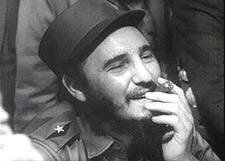
Background on Cuban Americans

Some of the first Cuban immigrants were merchants who set up businesses in New York and Philadelphia. Then in the late 1860s, and 1870s, many Cuban cigar manufacturers built factories in the United States, which provided many jobs for Cuban immigrants. While some immigrants remained in the United States, others went back to Cuba.
Other Cubans came to the United States for political reasons. Over the years, Cuba fought against Spanish rule. During the Ten Years' War (1868-1878), thousands of Cubans came to the United States, mostly settling in New York and Philadelphia, Orleans, Boston and Key West. The United States helped Cuba in 1898, by declaring war against Spain (the Spanish-American War). In 1902, Cuba finally became independent of Spain.
In 1933, Fulgencio Batista started a revolt to take over the Cuban government. After being made president and then retiring, Batista overthrew the government again in 1952. During the time of Batista's rule in Cuba, many more Cubans immigrated to the United States. In 1958, Fidel Castro and Fidelistas overthrew Batista. At first, everyone welcomed this change because they were happy that Batista was gone. Soon, however, Castro turned Cuba into a communist country and Cuba became good friends with the Soviet Union.
Wealthy Cubans had their property taken away. Many of these wealthy Cubans, known as "golden exiles," fled Cuba for the United States. From 1959 until 1962, more than 200, 000 Cubans came to the United States. After that, until 1965, about 50,000 Cubans flew to countries such as Spain or Mexico, and then boarded plans to this country.
In 1965 Castro said that Cubans who had relatives living in America could leave on boats from the port of Camarioca. As a result, people rushed to America to board often very small boats, and many died tying to cross from Camarioca to Florida. Cuba and America began "Freedom Flights" between Varadero, Cuba, and Miami, which carried 300,000 Cubans. These flights were stopped by Castro in 1973, and few Cubans were allowed to leave the country.
In 1978, Cuban Americans were invited to return to their native country for one-week visits with relatives. The visits made many Cubans excited to immigrate to this country. Two years later, in 1980, a group made their way into Peruvian embassy in Havana and demanded to leave the country. After they were allowed to leave, 10,000 people also declared that they wanted visas to leave the country. Castro didn't want to look bad, so he said that anyone who wanted to go to the United States could leave from the port of Mariel. In just five months, more than 125,000 Cubans left Mariel.
Trips between the two countries began again in 1988, but Cubans who couldn't afford the voyage, or get visas, tried to cross the sea to Key West. Many of these people lost their lives. When the Soviet Union ended in 1991, Cuba lost its economic help. As a result, there was a shortage of food and lack of jobs. Three years later, in 1994, Castro said that anyone who wanted to leave Cuba by sea was free to do so. Another group of balseros-rafters-tried crossing the sea. Because many died, Cuba and the United States agreed that all balseros going to the United States would have to go back to Cuba.
More than one million Cubans entered the United States between 1960 and 1995-about ten percent of the island's population. Not since the great immigration of the Irish in the 1800s has so high a percentage of a country's people come to America.
Adapted from Immigration by Sarah J. Glasscock